Project details
Skill
Cost
Estimated Time
We may be compensated if you purchase through links on our website. Our team is committed to delivering honest, objective, and independent reviews on home products and services.
Building a deck can transform your outdoor living space, and provide a brand new environment for relaxation and entertainment. With the right tools and some do-it-yourself grit, you can complete this construction yourself. Read our guide below to learn how to build a simple deck according to local business codes, and how to outfit it with the perfect finishing touches.
Planning Your Deck
Consider the following variables while planning your deck:
- Budget
- Complexity of the build
- Size and location
- Local building codes and permits
- Materials
Choosing Decking Materials
The right materials can make all the difference when you’re constructing your deck. Consider the different available options below.
- Cedar or redwood: More expensive than other options but are naturally pest- and rot-resistant
- Composite or PVC: Low-maintenance and strong
- Pressure-treated lumber: Less expensive than other options and durable, but needs regular maintenance to prevent weathering and rot
Tools and Materials for Deck Building
Gather the tools and materials below before you begin construction:
- Carpenter’s square
- Circular saw
- Concrete for footings
- Decking boards
- Drill
- Hammer
- Joist hangers and other hardware
- Level
- Pressure-treated lumber for framing
- Post-hole digger or auger
- Safety gear (gloves, goggles, ear protection)
- Screws and nails
- Tape measure
Anatomy of a Deck
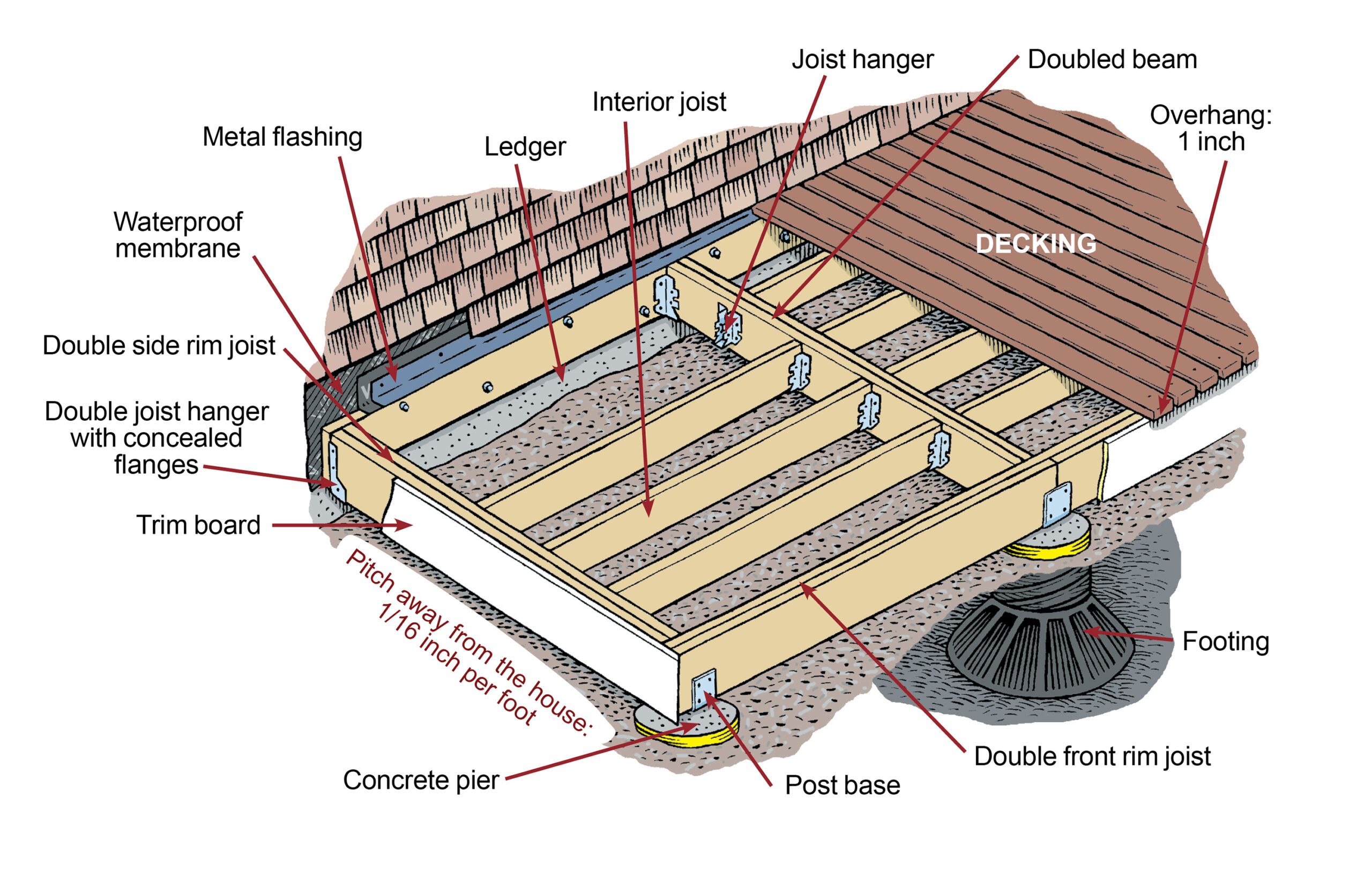
The deck shown here features a pressure-treated floor frame that’s supported by a ledger board and concrete piers. A 5/4-inch decking tops it. The deck is only one step high, so no railing is required. The frame is the foundation and provides stability and support for the decking boards. The frame comprises several parts, including the ledger board, footings, piers, and the deck’s joists.
Steps for Building a Deck
Carefully follow the steps below to build your deck.
Step 1: Attach the Ledger
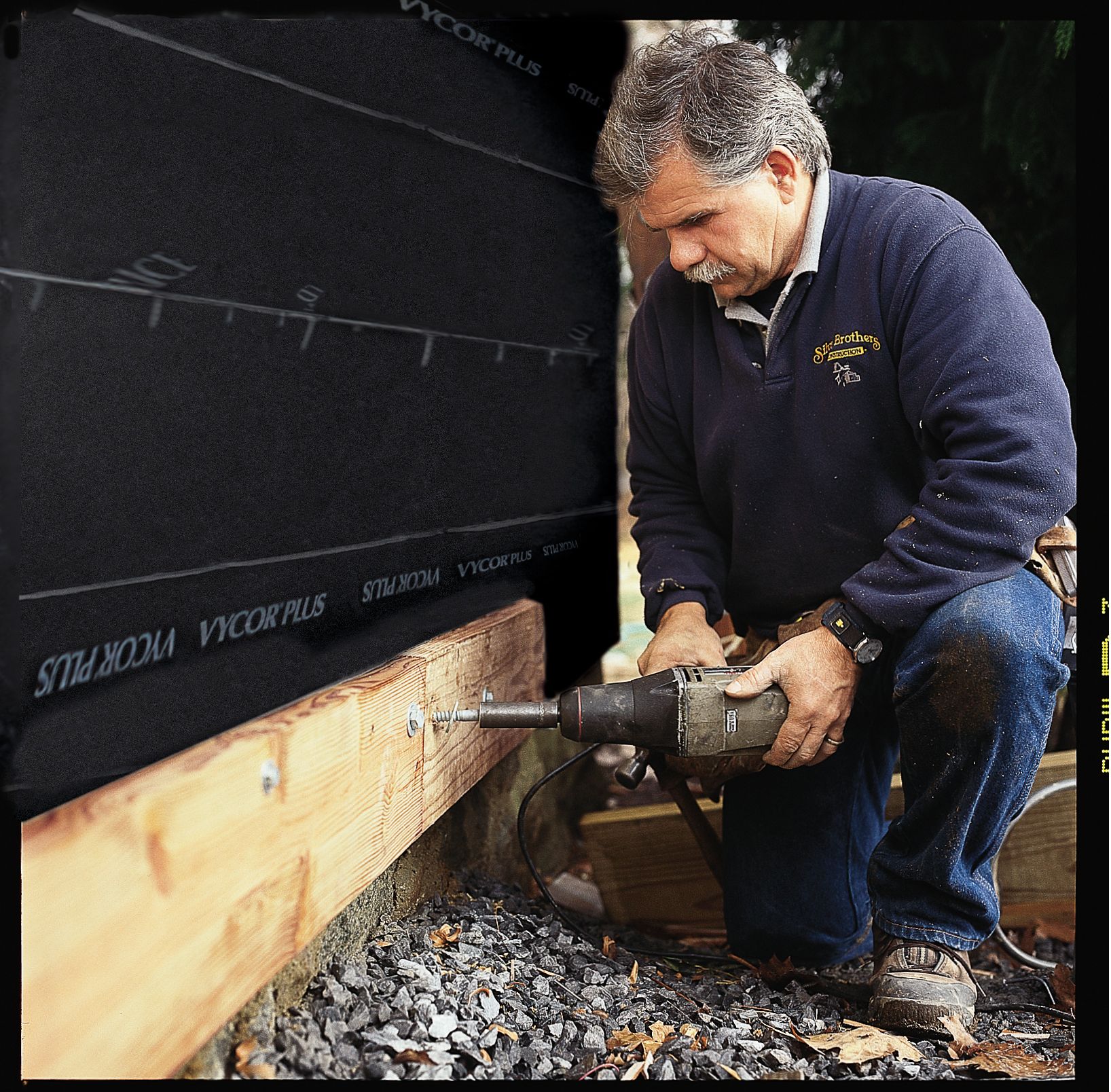
Remove the building’s trim and siding until it’s 1 foot above the top of where the ledger will sit. Cover the exposed sheathing with self-adhering waterproof membrane.
Mark the exact location of the top of the ledger. Any step down to the finish decking, which sits atop the ledger, must be 4 to 7 3/4 inches below the door sill, according to code. Mark a level chalk line.
Cut a 2-inch-wide, 1 1/2-inch-thick treated wood spacer for every 2 feet of ledger length. Align the top of each spacer with the chalk line and fasten with a 6d nail.
Align the ledger with the tops of the spacers and nail it to the wall at each spacer with a 16d nail. Joints between ledger boards should fall on a spacer.
Drill a 3 3/8-inch pilot hole through the ledger and into the house’s rim joist at each spacer, and follow a zigzag pattern. Insert a 1/2-inch lag screw in each hole and tighten it against a washer using an impact wrench or socket wrench.
Step 2: Protect the Ledger
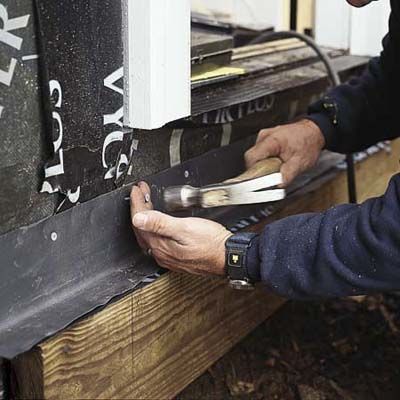
Cut a strip of self-adhering waterproof membrane that’s 6 inches wide and the same length as the ledger.
Fold the membrane lengthwise along its center line to form a right angle. Apply it over the ledger-to-house joint so one leg covers the top of the spacer blocks and ledger, and the other leg extends up the wall.
Cut a strip of metal flashing that’s at least 6 inches wide and as long as the ledger. If you need more than one strip of flashing, overlap the ends by 3 inches and bed them in siliconized acrylic caulk.
Fold the metal lengthwise to form a right angle. Apply it over the waterproof membrane.
Drive roofing nails through the flashing’s top edge every 8 inches.
Fasten concealed-flange double joist hangers at both ends of the ledger and flush with the ledger’s bottom edge using joist hanger nails.
Step 3: Set Footings and Piers

Set up batter boards and mason’s strings. Determine footing locations at the deck’s outside corners and at 8-foot intervals along the front rim joist. Mark each location, then temporarily remove the mason’s strings.
Dig a hole that’s wide enough to hold the footing form and deep enough to extend below the frost line at each footing location.
Assemble footing and pier forms according to the manufacturer’s instructions, then position one in each hole. Gently backfill.
To determine each pier’s finish height, run a level line from the top of the ledger to the pier tube. From this line, measure down 1/16 inch per foot of the pier’s distance from the house, plus the height of the rim joist and post base. Mark the form at this point. Repeat for each pier. Trim pier tubes at these marks.
Check the positioning of the piers and adjust if necessary. Fill with concrete, using a shovel to work out air pockets. Allow the concrete to cure for one week.
Step 4: Install Post Bases and Side Rim Joists
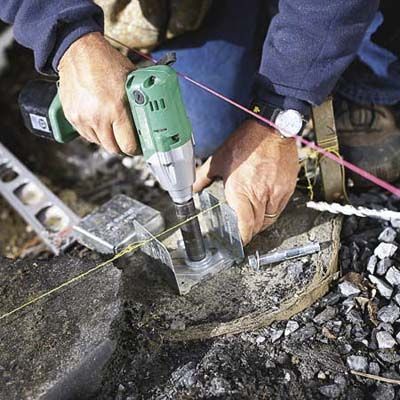
Place a post base atop a pier, and position it so that it doesn’t interfere with joist hangers. Mark its location. Remove the post base and bore into the pier with a hammer drill that’s equipped with a masonry bit. Reposition the post base, insert an anchor bolt, and tighten it with an impact wrench. Repeat for each pier.
Cut pressure-treated 2x stock for the doubled-side rim joists and beams. Glue them with construction adhesive and nail them together from both sides with 12d nails that you space every 16 inches in a zigzag pattern.
Fit a side rim joist into a joist hanger at one end of the ledger, square the corner, and toenail through the hanger into the ledger with 16d nails. Rest the joist’s opposite end on a corner pier. Repeat this with the other side joist, and remove any mason’s strings as necessary.
Cut pressure-treated 2x stock for the deck’s front rim joist. Stagger any butt joints by varying board lengths, and make sure joints fall in the middle of the post anchors.
Step 5: Install Front Rim Joist, Beams, and Interior Joists
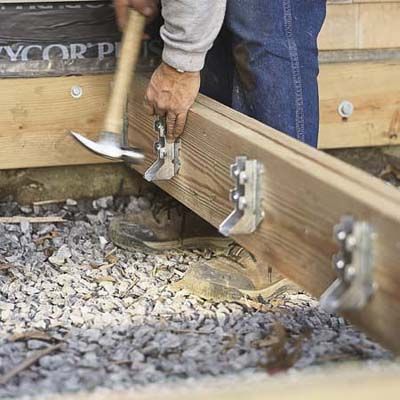
Fasten concealed-flange double joist hangers on the ends of the front rim joist’s inner 2xs. Then fit the inner 2xs into the post bases.
Fit a side rim joist into a front hanger, and square the corner. Secure the front rim joist 2x to the post bases with hanger nails. Then drive six 16d nails through the face of the front rim joist into the end of the side rim joist. Repeat this step with the other side rim joist.
Fasten face-mounted double joist hangers for beams every 8 feet on center along the front rim joist and ledger so that they’re flush with bottom edges.
Fit and nail each beam as described above.
Complete the doubled front rim joist by gluing and nailing the outer 2xs to the inner 2xs.
Install 2x joist hangers along the beams, 16 inches on center. Joists should be flush with the top edge of the ledger, rim joists, and beams.
Step 6: Install Front Rim Joist, Beams, and Interior Joists (continued)
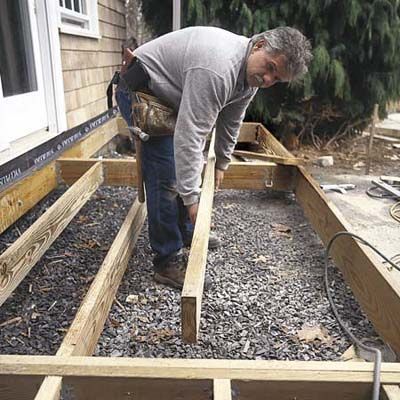
Fit and toenail the joists through the hangers. If the joist has a crown, which is a slight arc along its edge, install it crown-side up.
Step 7: Attach Trim and Decking
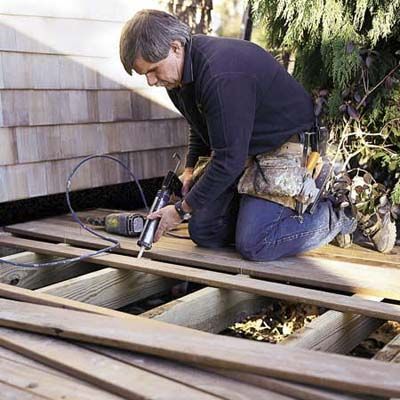
Nail paint-grade trim boards that are as wide as the rim joists to the joists’ outside faces with two 8d hot-dipped galvanized or stainless finish nails. Space them every 12 to 16 inches. Scarf any joints in the run, and miter joints at the corners.
Measure the distance from the wall to the outside of the trim board and add 1 inch for overhang. Cut the deck boards to this length.
Squeeze a bead of polyurethane marine sealant onto the top edge of a side rim joist. This adhesive fastens the decking in place. Lay a straight deck board in the adhesive so its long edge overhangs the trim board by 1 inch. Secure each end of the deck board with an 8d finish nail.
Tack 8d finish nails into the joists alongside the first board to maintain consistent spacing. Squeeze dabs of adhesive onto the top edge of each joist. Lay and nail the next deck board the same way. Continue gluing and nailing until the deck is complete. Add more nails only if a board does not lie straight or flat.
Replace the house’s siding so that it’s within 1/2 to 1 inch of the decking. Remember that decking you lay at right angles to the house makes for a stronger front edge.
Stairs and Railings for a Deck
If your deck is more than 30 inches above grade, you’ll need to add stairs and railings for safety and accessibility. Stairs that you properly design and construct enhance the deck’s functionality and aesthetic appeal.
Build Stairs
Follow the steps below to construct stairs:
- Calculate the rise and run of each step. They should be consistent to prevent tripping hazards.
- Cut stringers to support the treads and risers.
- Attach stringers to the deck frame.
- Install treads and risers. Make sure you securely connect the stairs to the deck and landing pad.
Install Railings
Follow the steps below to install railings:
- Install posts at corners and intervals along the deck edge.
- Attach top and bottom rails between posts.
- Install balusters between the rails, ensuring they meet local code requirements for spacing.
The spacing between balusters is typically required to be less than 4 inches to prevent children from slipping through.
Finishing Touches for Your Deck
Follow the tips below to add finishing touches to your deck:
- Add lighting to make the deck more accessible in the evenings.
- Add post caps for a polished look, and to protect the tops of the posts from water damage.
- Apply a water-resistant finish to protect wood decking from moisture and UV damage.
- Include seating or planter boxes as part of your deck design.
- Install fascia boards to cover the ends of joists and beams.















